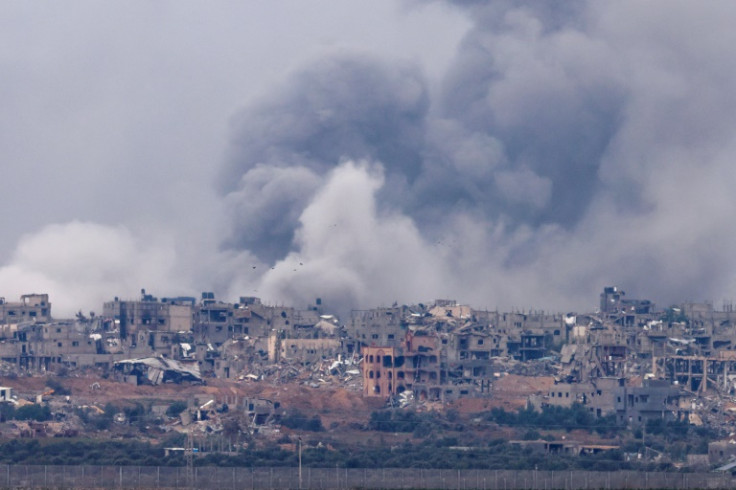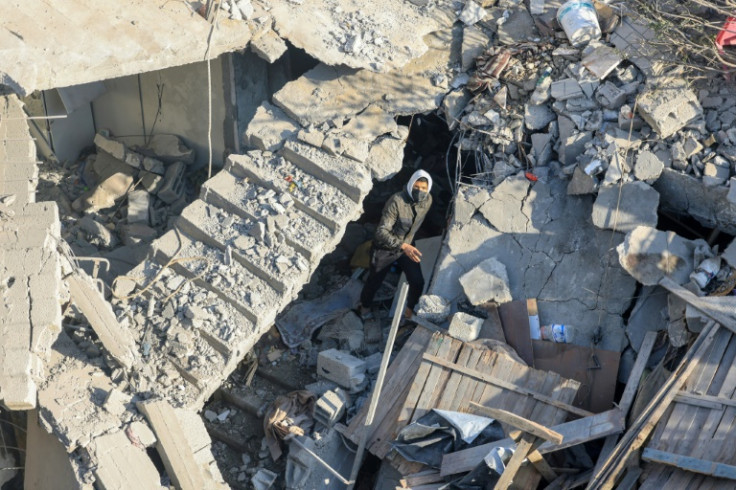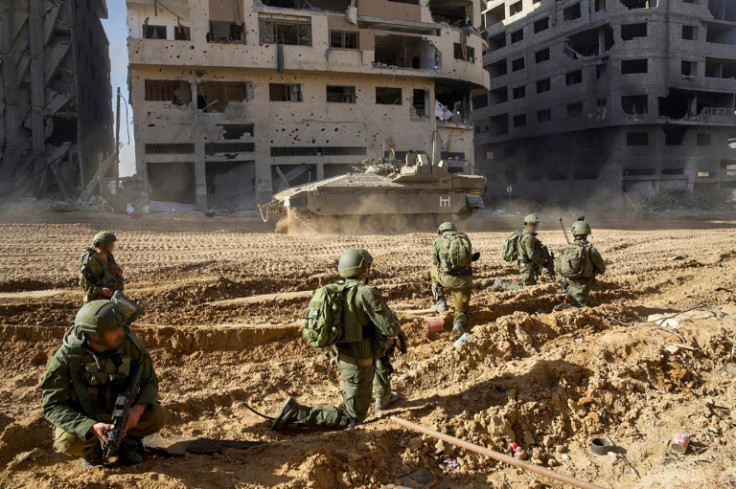Urban Fighting Rages In Gaza As War Enters Third Month
Heavy urban combat raged in and around Gaza's biggest cities on Thursday as the bloodiest-ever war between Israel and Palestinian group Hamas entered its third month since the militants' attack on October 7.

Heavy urban combat raged in and around Gaza's biggest cities on Thursday as the bloodiest-ever war between Israel and Palestinian group Hamas entered its third month since the militants' attack on October 7.
The death toll in Gaza has soared to 17,177 according to the Hamas-run health ministry, and vast areas of the besieged territory have been reduced to a rubble-strewn wasteland of bombed-out and bullet-scarred buildings.
Israeli forces have encircled major urban centres as they seek to destroy Hamas over its unprecedented attack in October when militants broke through Gaza's militarised border to kill around 1,200 people and seize hostages, 138 of whom remain captive, according to Israeli figures.
Backed by air power, tanks and armoured bulldozers, Israeli troops were fighting Thursday in Khan Yunis, the biggest city in southern Gaza, as well as in Gaza City and the nearby Jabalia district of the north.
Prime Minister Benjamin Netanyahu said troops had closed in on the Khan Yunis home of Hamas's Gaza chief Yahya Sinwar, 61, vowing "it is only a matter of time until we find him".
Netanyahu's government responded angrily to United Nations chief Antonio Guterres after he invoked the rarely-used Article 99 of the UN charter, calling on the Security Council to push for a ceasefire.

Foreign Minister Eli Cohen said this would help Hamas and that Guterres was "a danger to world peace".
"Two months on the road, moving from one place to another. These are the hardest two months we have experienced in our lives," said Abdallah Abu Daqqa, displaced from Khan Yunis to Rafah.
Gazans have been pushed south, turning Rafah near the Egyptian border into a vast camp for many of the 1.9 million Palestinians displaced by the conflict -- 80 percent of Gaza's population.
But air strikes have followed them.

Eight more hit Rafah overnight. AFP journalists saw around 20 corpses in white body bags, including a child, at its Nasser hospital, while men gathered nearby to pray.
Mass civilian casualties have sparked global concern, heightened by dire shortages caused by an Israeli siege that has seen only limited access for food, water, fuel and medicines.
Israel has approved a "minimal" increase in fuel supplies to prevent a "humanitarian collapse and the outbreak of epidemics", and called on the international community to "increase its capabilities" to distribute aid.
UN humanitarian chief Martin Griffiths said there were "promising signs" Israel may open the southern Kerem Shalom crossing to aid deliveries.
But Hamas has declared a "state of famine" in northern Gaza, saying no aid had arrived there since December 1.

And Israeli rights group B'Tselem said the "miniscule amount of aid" allowed into the territory was "tantamount to deliberately starving the population".
"We are dying here, without even the need for rockets and bomb strikes. We are dead already, dead from hunger, dead from displacement," said Abdelkader al-Haddad, a Gaza City resident now in Rafah.
The deaths of six more Israeli soldiers were announced, raising the toll inside Gaza to 89, said the military.
In a morning briefing, it said troops had "killed Hamas terrorists and struck dozens of terror targets" in Khan Yunis, and raided a military compound of Hamas's Central Jabalia Battalion.
Naval forces hit Hamas military compounds and infrastructure "using precise ammunition and firing shells".
Hamas released footage of its fighters shooting AK-47 assault rifles and grenade launchers from abandoned buildings in what it said was Gaza City, and said it was battling Israeli troops "on all axes of the incursion into the Gaza Strip".

The militant group said it had destroyed two dozen military vehicles in Khan Yunis and Beit Lahia in the territory's north, and its rockets continue to target Israel, though they have been intercepted by air defences.
Netanyahu warned Hezbollah that if it "chooses to start a global war, then it will turn Beirut and South Lebanon... into Gaza and Khan Yunis with its own hands".
An investigation by Agence France-Presse into a strike in southern Lebanon on October 13 that killed a Reuters journalist and injured six others, including two from AFP, concluded that it involved a tank shell only used by the Israeli army in this region.
Watchdog Reporters Without Borders (RSF) urged Israeli and Egyptian authorities to allow journalists to move freely over the Rafah crossing.
Israeli TV appeared to show scores of stripped Palestinian men sitting on a Gaza street in military custody.

The images, which appeared to come from Beit Lahia in northern Gaza, drew strong condemnation from London-based news outlet Al-Araby Al-Jadeed, which said one of its journalists was among them.
Israelis remained deeply traumatised by the horror of the Hamas attack and fearful for the fate of hostages as they headed into the Jewish festival of lights, Hanukkah, from Thursday evening.
One of the worst-hit sites on October 7, the Supernova music festival, was recreated in a Tel Aviv exhibition hall to remember those killed and abducted by Hamas, complete with victims' tents and recovered belongings.
In Jerusalem, candlesticks were arranged as usual for the Jewish festival, and customers lined up for Hanukkah doughnuts.
© Copyright AFP 2025. All rights reserved.





















